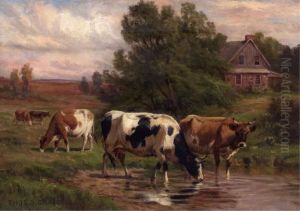Thomas B. Craig Paintings
Thomas B. Craig was an American landscape painter known for his tranquil pastoral scenes. Born in Philadelphia, Pennsylvania, in 1849, Craig developed an interest in art at an early age. He was primarily self-taught, although he did receive some informal training from other artists of the time. His approach to painting was influenced by the Hudson River School, a mid-19th century American art movement embodied by a group of landscape painters who were inspired by romanticism. The Hudson River School artists were known for their realistic and detailed portrayal of American landscapes, celebrating the beauty and grandeur of the countryside.
Craig's work often depicted the agricultural landscapes of Pennsylvania, New Jersey, and New York. His paintings are characterized by their serene and idyllic qualities, with a focus on the harmonious relationship between nature and the small-scale farming practices of the time. Craig's use of light and color was subtle, and he had a keen eye for capturing the atmospheric effects of different seasons and times of day.
Throughout his career, Thomas B. Craig exhibited at various art institutions, including the Pennsylvania Academy of the Fine Arts and the National Academy of Design. Despite his modest success during his lifetime, Craig did not achieve the same level of fame as some of his contemporaries. Nevertheless, his work has been appreciated for its quiet beauty and contribution to American landscape painting.
Craig continued to paint until his later years, maintaining his dedication to the bucolic landscapes that had always inspired him. He passed away in 1924, leaving behind a legacy of peaceful and pastoral scenes that continue to evoke a sense of calm and nostalgia for the rural life of 19th-century America.
